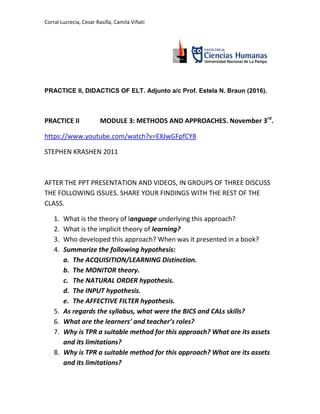
The natural approach quiz
- 1. Corral Lucrecia, Cesar Rasilla, Camila Viñati PRACTICE II, DIDACTICS OF ELT. Adjunto a/c Prof. Estela N. Braun (2016). PRACTICE II MODULE 3: METHODS AND APPROACHES. November 3rd . https://www.youtube.com/watch?v=EXJwGFpfCY8 STEPHEN KRASHEN 2011 AFTER THE PPT PRESENTATION AND VIDEOS, IN GROUPS OF THREE DISCUSS THE FOLLOWING ISSUES. SHARE YOUR FINDINGS WITH THE REST OF THE CLASS. 1. What is the theory of language underlying this approach? 2. What is the implicit theory of learning? 3. Who developed this approach? When was it presented in a book? 4. Summarize the following hypothesis: a. The ACQUISITION/LEARNING Distinction. b. The MONITOR theory. c. The NATURAL ORDER hypothesis. d. The INPUT hypothesis. e. The AFFECTIVE FILTER hypothesis. 5. As regards the syllabus, what were the BICS and CALs skills? 6. What are the learners’ and teacher’s roles? 7. Why is TPR a suitable method for this approach? What are its assets and its limitations? 8. Why is TPR a suitable method for this approach? What are its assets and its limitations?
- 2. Corral Lucrecia, Cesar Rasilla, Camila Viñati 1- Tracy Terrell and Stephen Krashen, who developed the “Natural Approach”, see communication as the primary function of the language. Their approach focuses on teaching communicative abilities as an example of communicative approach. Terrell and Krashen emphasize the primacy of meaning and the importance of vocabulary in which the most important thing is to get the words in. “The input hypothesis states that in order for acquirers to progress to the next stage in the acquisition of the target language, they need to understand input language that includes a structure that is part of the next stage” (Krashen and Terrell 1983:32). They feel that grammatical structure does not require explicit analysis or attention by the language teacher, by the language learner, or in language teaching materials. 2- The Theory of Learning is based on an empirically grounded theory of second language acquisition, which has been supported by a large number of scientific studies in a wide variety of language acquisition and learning contexts. 3- In 1997, Tracy Terrell, a teacher of Spanish in California, and Stephen Krashen, an applied linguist at the University of Southern California, created the Natural Approach. The book “The Natural Approach” was published in 1983. In this book they combined statements of the principles and practices of this approach. It contains theoretical sections that outline Krashen´s views on second language acquisition, and sections on implementation and classroom procedures. 4- The ACQUISITION/LEARNING Hypothesis. It claims that there are two distinctive ways of developing competence on a second language: Acquisition is the “natural” way and it refers to an unconscious process that involves the naturalistic development of language proficiency through understanding language and through using language for meaningful communication. Learning refers to a process in which conscious rules about a language are developed.
- 3. Corral Lucrecia, Cesar Rasilla, Camila Viñati The MONITOR Hypothesis. Conscious learning can function as a monitor or editor that checks and repairs the output of the acquired system. It claims that we may call upon learned knowledge to correct ourselves when we communicate, but that conscious learning has only this function. The NATURAL ORDER hypothesis. The acquisition of grammatical structures proceeds in a predictable order. Certain grammatical structures or morphemes are acquired before others in first language acquisition of English, and a similar natural order is found in second language acquisition. Errors are signs of naturalistic developmental processes. The INPUT hypothesis. It explains the relationship between what the learner is exposed to of a language (the input) and language acquisition. The AFFECTIVE FILTER hypothesis. Krashen sees the learner’s emotional state or attitudes as an adjustable filter that passes, impedes or blocks input necessary to acquisition. There are three kinds of affective or attitudinal variables related to L2: Motivation: Learners with high motivation generally do better. Self-Confidence: Learners with self-confidence and good self-image tend to be more successful. Anxiety: Low personal and classroom anxiety are more conductive to second language acquisition.
- 4. Corral Lucrecia, Cesar Rasilla, Camila Viñati 5- BIC: Basic Intercommunication Skills. They refer to linguistic skills needed in everyday, social face-to-face interactions. *Basic personal communication skills: oral (e.g. listening to announcements in public places) written (e.g. reading and writing personal letters). CALP: Cognitive Academic Language Performance. It focuses on proficiency in academic language used in the classroom in the various content areas. *Academic learning skills: oral (e.g. listening to a lecture) written (e.g. taking notes in class). 6- Learner Roles: Learners should not try to learn a language in the usual sense. The language acquirer is seen as a processor of comprehensible input. The acquirer is challenged by input that is slightly beyond his/her current level of competence and is able to assign meaning to this input through active use of context and extra linguistic information. Learners can make decisions on when to speak, what to speak about, and what linguistic expressions to use in speaking. Teacher Roles: The teacher is the primary source of comprehensible input in the target language. He/She generates a constant flow of language input. The teacher creates a classroom atmosphere that is interesting, friendly, and in which there is a low affective filter. The teacher must choose a mix of classroom activities, involving a variety of group sizes, content, and contexts.
- 5. Corral Lucrecia, Cesar Rasilla, Camila Viñati 7- TPR is a suitable method for this approach because it maintains a constant flow of “comprehensible input”, using key vocabulary items, appropriate gestures, context, repetition, and paraphrase to ensure the comprehensibility of the input. This method emphasizes comprehensible and meaningful practice activities, rather than production of grammatically perfect utterances and sentences.